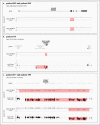Copy Number Analysis in a Large Cohort Suggestive of Inborn Errors of Immunity Indicates a Wide Spectrum of Relevant Chromosomal Losses and Gains
- PMID: 35486341
- PMCID: PMC9402522
- DOI: 10.1007/s10875-022-01276-8
Copy Number Analysis in a Large Cohort Suggestive of Inborn Errors of Immunity Indicates a Wide Spectrum of Relevant Chromosomal Losses and Gains
Abstract
Inborn errors of immunity (IEI) are genetically driven disorders. With the advancement of sequencing technologies, a rapidly increasing number of gene defects has been identified, thereby mirroring the high heterogeneity in immunological and clinical presentations observed in patients. However, for a large majority of patients, no causative single nucleotide variant (SNV) or small indel can be identified using next-generation sequencing. First studies have shown that also copy number variants (CNVs) can cause IEI. Unfortunately, CNVs are not well examined in many routine diagnostic settings and the aim of this study was to assess the number of clinically relevant chromosomal losses and gains in a large cohort. We identified a total of 20 CNVs using whole exome sequencing data of a cohort of 191 patients with a suspected IEI. A definite molecular diagnosis could be made in five patients (2.6%), including pathogenic deletions affecting ICOS, TNFAIP3, and 22q11.2. CNVs of uncertain significance were observed in fifteen patients (7.9%), including deletions of 11q22.1q22.3 and 16p11.2 but also duplications affecting entire or parts of genes previously associated with IEI. Importantly, five patients carrying a CNV of uncertain significance also carried pathogenic or likely pathogenic SNVs (PIK3R1, NFKB1, NLRC4, DOCK2), or SNVs of unknown significance (NFKB2). This cooccurrence of SNVs and CNVs suggests modifying effects in some patients, and functional follow-up is warranted now in order to better understand phenotypic heterogeneity. In summary, the diagnostic yield of IEI can be increased substantially by evaluating CNVs, which allows an improved therapeutic management in those patients.
Keywords: CNV; Inborn errors of immunity; Primary immunodeficiency; SNV; WES.
© 2022. The Author(s).
Conflict of interest statement
The authors declare no competing interests.
Figures
References
-
- Thalhammer J, Kindle G, Nieters A, Rusch S, Seppanen MRJ, Fischer A, et al. Initial presenting manifestations in 16,486 patients with inborn errors of immunity include infections and noninfectious manifestations. J Allergy Clin Immunol. 2021;148(5):1332–41.e5. doi: 10.1016/j.jaci.2021.04.015. - DOI - PubMed
-
- Tangye SG, Al-Herz W, Bousfiha A, Chatila T, Cunningham-Rundles C, Etzioni A, et al. Human inborn errors of immunity: 2019 update on the classification from the International Union of Immunological Societies Expert Committee. J Clin Immunol. 2020;40(1):24–64. doi: 10.1007/s10875-019-00737-x. - DOI - PMC - PubMed
Publication types
MeSH terms
LinkOut - more resources
Full Text Sources
Medical
Miscellaneous


